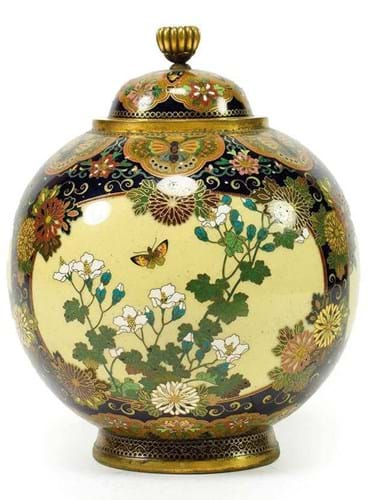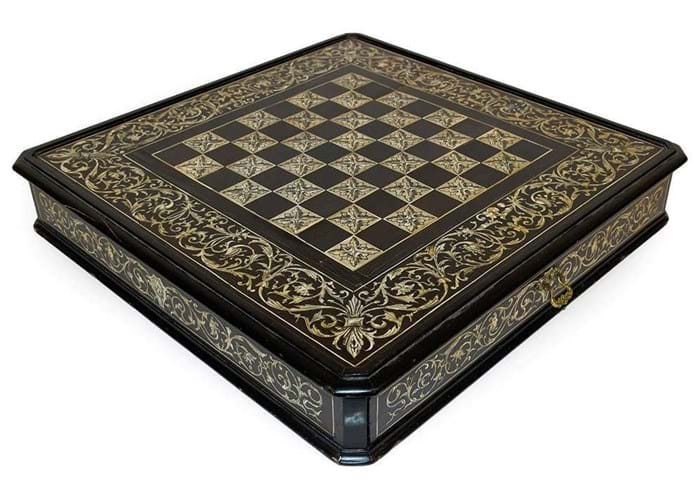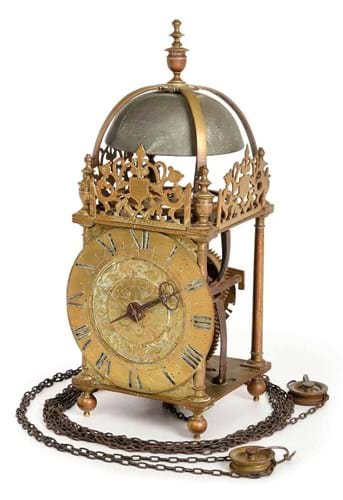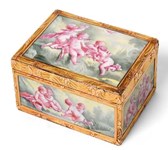While dominated by the £68,000 pair of French ormolu-mounted, white marble and porphyry candelabra illustrated on the front page of ATG No 2503, the Summer Fine Art auction at Tennants (20% buyer’s premium) enjoyed highlights across a diverse range of collecting disciplines.
A Japanese koro by Namikawa Yasuyuki, a Renaissance revival ivory and ebony chessboard and a Rolex made to commemorate the UK Apache helicopter operations were all part of the Leyburn sale on July 16-17. In all, 86% of the 471 lots were sold, totalling £403,550.
Reynolds commission
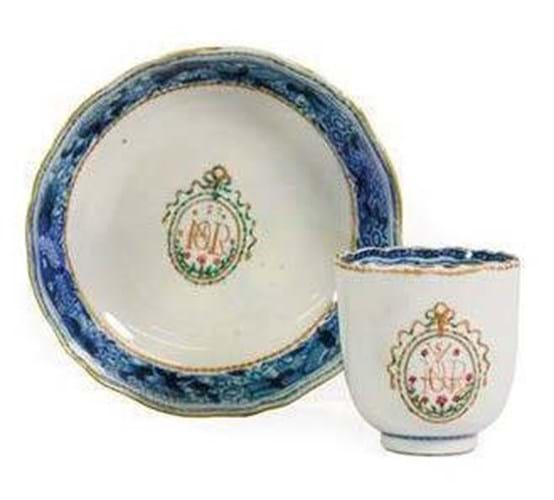
One of two pairs of Chinese export coffee cups and saucers from a service commissioned by portraitist Sir Joshua Reynolds – this one made £600 at Tennants.
A pair of Chinese export coffee cups and saucers were from a service commissioned by portraitist Sir Joshua Reynolds (1723-92). Both are decorated with a monogram, almost certainly designed by Reynolds himself, which is constructed using all the letters in his name and title.
Elements of the service, c.1785, are noted in David Sanctuary Howard’s Chinese Armorial Porcelain (1974) together with an illustration of a tea caddy which is held in the collection of Dr Johnson’s House in the City of London.
Tennants’ pieces hailed from the private collection of the Aylmer family, who are descended from Reynolds’ elder sister, Mary Palmer (1716-94). Sold separately, each had an estimate of £200-300, but they brought differing prices on account of condition. The better of the two sold at £600 while the other, with a broken and restored saucer, made £300.
From 1695-1820, some 4000 families are known to have imported crested services before the imposition of a hefty import tax made Chinese porcelain prohibitively expensive.
Also popular with courtly Europeans at the time were the blue and white ‘scholar’s’ wares made during the 17th century. At Tennants a 10in (25.5cm) tall rouleau vase painted with a mountainous landscape bore a Chenghua reign mark (1464-87) but was catalogued as probably Kangxi (1661-1722).
Pitched at £1000-1500, it sold to a UK collector against Chinese interest at £5500.
It was a Japanese piece which led the Asian material: a c.1880-90, 4in (10.5cm) tall spherical cloisonné enamel koro and cover by the remarkable Namikawa Yasuyuki (1845-1927).
Having been a Samurai during the last years of the military nobility, Yasuyuki turned to art with the Meiji Restoration, joined the Kyoto Cloisonné Company in 1871 and set up on his own three years later.
He enjoyed almost immediate success, becoming one of only two cloisonné artists ever appointed as imperial household artist. Tennants’ piece, worked in coloured enamels and gold and silver wire and bearing a four-character signature to a silver tablet, was textbook stuff. There was Asian interest but a London dealer took it at £12,000, triple the midestimate.
A 17-lot collection of 18th century English glass was topped by an early heavy baluster – a very popular collecting niche of late. This example dating from c.1710 was 6¼in (16cm) tall and had a triple-collar stem. It sold at £3000, the same bid tendered for a 7½in (19.5cm) tall, c.1730, goblet moulded with nipped diamond waves to the funnel bowl. Both pieces went to collectors.
Two very different English ceramic lots took £950: a pair of 9in (23cm) tall Chelsea Gold Anchor baluster vases and covers with some losses and repairs sold to the London trade and a c.1800 Prattware stirrup cup modelled as a hound catching a hare sold to an overseas collector.
Board beauty
Outstanding among the collectables on the second day was a c.1880, 17¾in (45cm) square chess board signed to the frieze drawer Ferd[inand] Pogliani, Milano, Ebeniste – a highly fashionable 19th century specialist in Renaissance-style ebony and ivory works.
Estimated at £1200-1500, the board had some minor lifting to the veneers and a split to one top edge moulding but sold to a UK private buyer at £8500.
Eye-catcher among the clocks was a c.1655 striking lantern clock signed Richard Beck at Ye French Church, Londini. The 15¼in (39cm) tall four-post case was missing its wrought-iron back and brass sides and the 30-hour movement lacked the alarm work. However, Beck was a respected maker and, having died aged 27 in 1659, his works are rare. This one went to the UK trade at a top-estimate £5000.
Topping the furniture was a mahogany triple-pillar dining table from the second quarter of the 19th century. Extending to 11ft 6in (3.53m) with three extra leaves, the 4ft 3in (1.35m) wide table had some bruising and scuffing consistent with age but more than tripled the top estimate in selling to a UK private at £9500.
By contrast, a pair of carved giltwood girandole mirrors were in near showroom condition. Entirely regilded, barring the beak of one the surmounted ho-ho birds, and with later mirror plates and nozzles, the 2ft 8in (82cm) tall mirrors were dated to the third quarter of the 18th century and similar to a design in Chippendale’s 1754 Director.
Pitched at £4000-6000, they sold to the trade at £7200.
For a little more, one could almost furnish an entire elegant room in the later Georgian style.
A pair of neo-classical satinwood, tulipwood-banded and polychrome painted card tables, c.1790, were offered together with a similar suite of four armchairs and six single chairs, all with floral painted oval back supports, caned seats and turned legs.
Against a £3000-5000 estimate, the matched lot went to a private buyer at £8500.


